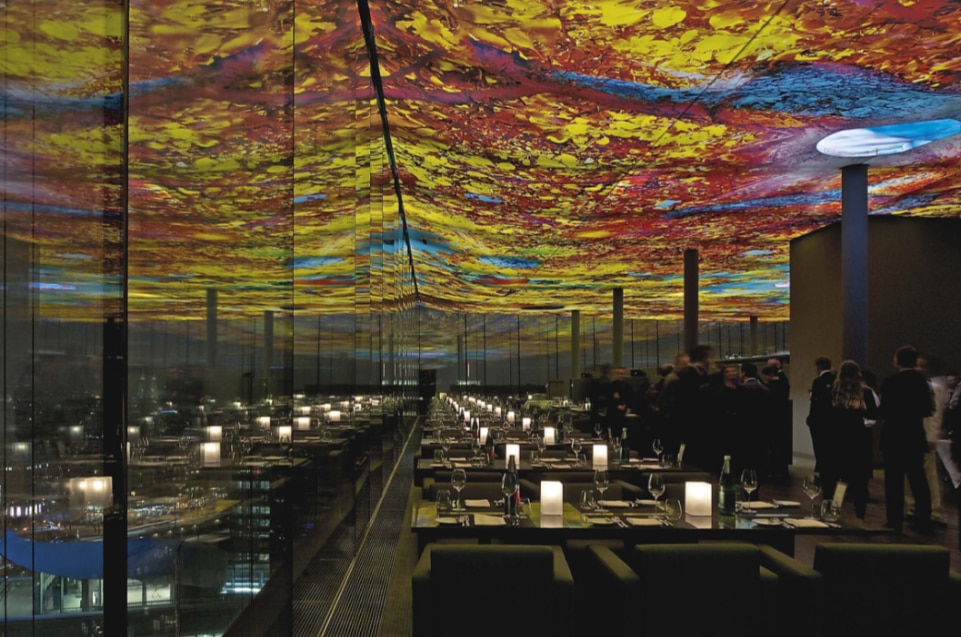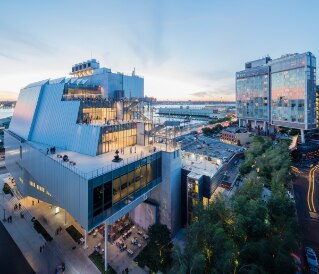By the late 2000s, Jean Nouvel’s research of a dialogue with the city mediated by ultra-controlled minimalism – contrasted by elements of surprise and visual explosions – had reached the highest levels of refinement in design process: it happened with Copenhagen's Koncerthuset, hiding its floating, luminous core behind the apparent opacity of its perforated metal facades, and it happened especially in the hotel completed by Nouvel in Vienna, in its dark, enigmatic masses ripped open by Pipilotti Rist's oversaturated, uncontrolled interventions. Such architectural positioning, with the interiors dominated by a minimalism that is not simply formal cleanliness – as John Pawson would also assert – but a design of visual and spatial experience, Nouvel would end up synthesizing a paradigm for the urban hôtellerie across a watershed decade.
Domus, of which Nouvel would become guest editor years later, published the project in July 2011, on issue 949.
.png.foto.rmedium.png)
Vienna, Luminous City
Presque rien, almost nothing. The specific connection that the French architect Jean Nouvel establishes with the immaterial, or, upon request, with the virtual – see his project for the Virtual House competition organised by the now-defunct magazine Any – has always been marked by concrete dialectics with real life. Nouvel himself has said that any evaporation of matter can be ascribed to a phase of the “Darwinian evolution toward dematerialisation that began with the dolmen and might end with nothing more than a magnetic field”, but all is grounded in a solid counterpoint: the body of things.
The “almost nothing” with which Nouvel describes his building for the new Sofitel Stephansdom in Vienna lies in the abstraction found in his monumental design. It is combined with his attempt to revive the traditional role that a grand hôtel used to have with regards to the city: a special exchange between urban life and the savoir vivre of hospitality, something that the policies of hoteldom have progressively relegated to the back burner, preferring instead (with some exceptions) to promote heterotopic islands of self-referentiality.
.png.foto.rmedium.png)
Located where the Taborstrasse meets the Donaukanal, the branch of the Danube that borders the historical city centre, the hotel’s neighbour across the street is the Generali Media Tower by Hans Hollein, which was completed ten years ago. Not a plain and simple tower, but a composition of solids that takes its cue from an urban fabric where the first bank and insurance buildings began arising in the 1950s. Just like Hollein created a reference to the surrounding heights, volumes and alignments back then, Nouvel has now related to Hollein in the inclined planes, materials and colours of his new hotel, establishing a well-defined architectural bond with the area.
From here on, the building becomes conceptual, almost looking inward. Nouvel adhered to strict logic in the palette of colours and materials: black, white, grey and mirror crisply mark each of the vertical monochrome facades; they are consequently mixed for the slanted glass roof of the belvedere, whose lozenge-shaped panes are a reference to the roof tiles of Saint Stephen’s Cathedral, which is visible from here. The same chromatic austerity continues in the rooms and is the result of a minimalist reductionism that is applied above all as the statement of “a process”. After all, that’s what minimalism should be, not merely an elegant kind of formal asceticism. Then all of a sudden, in contrast to the rarefying of forms, figurative elements flood the scene: floating horizontals of coloured light by the Swiss artist Pipilotti Rist –technological trompe l’œils that project a kaleidoscopic burst of reflections on all the optical transparencies of the surroundings.
.png.foto.rmedium.png)
Visual effects come easy to Jean Nouvel. The prisms of the Sofitel make for a stunning embrace of Vienna from all the large public spaces of the hotel. In the rooms, the views can be customised by specially designed window shutters that can be widened or contracted like the diaphragm of a camera lens, a favourite Nouvel metaphor also seen in his small gem that is the poetic The Hotel in Lucerne. In addition to Pipilotti Rist, Nouvel invited students from Vienna’s Academy of Fine Arts to make artwork for the Sofitel. The vertical gardener Patrick Blanc, who has been part of Nouvel’s adventures before, added a 600-square-metre wall of plants
But the importance of the ceilings by Rist, who was called upon to contradict on a horizontal plane all that goes on on the vertical (but not completely) plane, is something more. Not only is her role a classic no different from Georg Kolbe’s bronze Alba statue in the Barcelona Pavilion, to name a quintessential example of the Modern Movement. It is a phantasmagorical, fluid, nocturnal gift to the city. And Nouvel, who is the greatest surviving exponent of modernity, having breathed in its last vapours (according to Casciani’s Pritzker essay describing him in 2008) accompanies its transition by sublimating it, not without angst, in contemporary liquidity.









